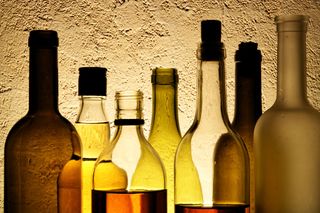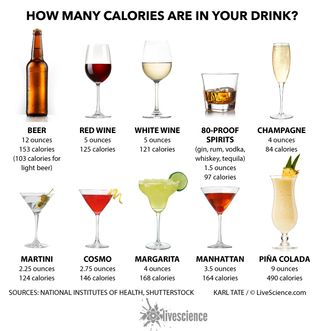
Cheers? Counting the Calories in Alcoholic Drinks

Alcohol can be a "hidden" source of calories — you may have a glass of wine (or two) with dinner, or champagne to ring in the New Year, without thinking about the extra calories you're consuming.
But alcoholic drinks can be a significant contributor to your daily calorie intake. A 2012 study found that the average American adult consumes 100 calories a day from beer, wine or other alcoholic beverages. And close to 20 percent of men and 6 percent of women consume more than 300 calories from alcohol daily, the study found. This can add up – for example, consuming 100 calories more than you burn every day may lead to a weight gain of 10 pounds over a year.
Because alcoholic drinks are essentially "empty" calories and don't contribute toward your daily nutrition, cutting back on alcohol may be one healthy way to lose weight.
Different types of alcoholic drinks pack varying amounts of calories. A 12-ounce glass of beer has about 150 calories, a 5-ounce glass of red wine has about 125 calories, and a 1.5 ounce shot of gin, rum, vodka, whiskey or tequila has about 100 calories, according to the National Institute on Alcohol Abuse and Alcoholism.
The drink with the fewest calories? Per serving, its champagne, which has 84 calories for every 4 ounces. (Beer, technically, has fewer calories per ounce, but we're guessing you'd be unlikely to drink just 4 ounces of a beer.)
Here's a look at how many calories are in different alcoholic drinks:

This article is part of a Live Science Special Report on the Science of Weight Loss.
Sign up for the Live Science daily newsletter now
Get the world’s most fascinating discoveries delivered straight to your inbox.
Follow Rachael Rettner @RachaelRettner. Follow Live Science @livescience, Facebook & Google+. Original article on Live Science.

Rachael is a Live Science contributor, and was a former channel editor and senior writer for Live Science between 2010 and 2022. She has a master's degree in journalism from New York University's Science, Health and Environmental Reporting Program. She also holds a B.S. in molecular biology and an M.S. in biology from the University of California, San Diego. Her work has appeared in Scienceline, The Washington Post and Scientific American.
Most Popular


